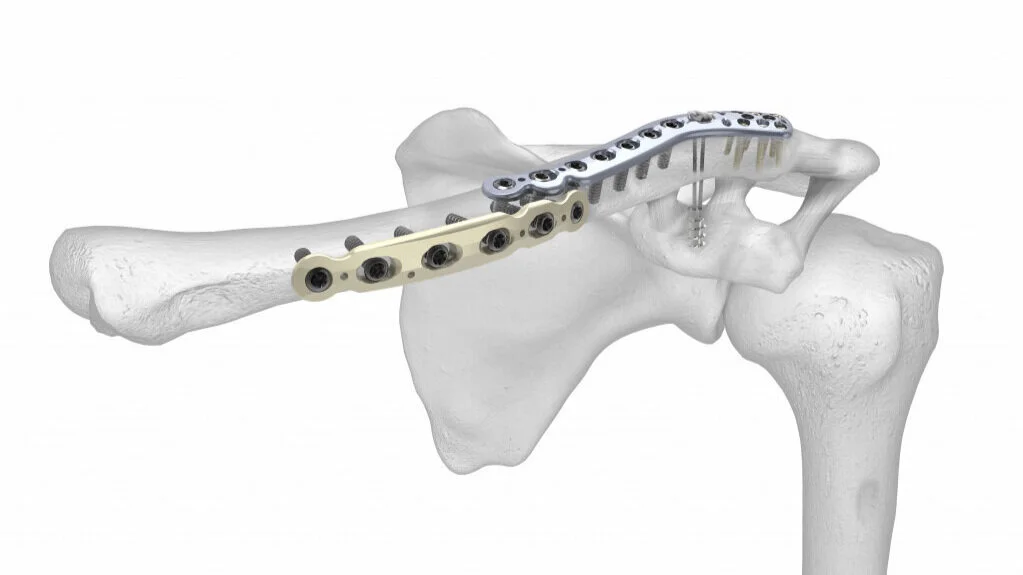Clavicle Fraction Fixation.
Why might I need clavicle fracture fixation?
Not everyone with a fractured clavicle needs fixation. If possible, Mr Moverley will advised treating your clavicle fracture with non-operative treatments, like pain medicines, physiotherapy and slings. You may benefit from clavicle fixation if:
The pieces of your clavicle are significantly out of alignment.
Your clavicle broke through the skin.
Your clavicle broke into more than two pieces.
You suffered from a high energy injury such as a road traffic accident.
You have already tried 3-6 months of non-operative treatment and your fracture is not healing. In these cases, fixation can realign your bones back into their proper configuration. This significantly increases the chance that your bone will heal properly.
What does surgery involve?
On the day of surgery you will be admitted to the ward or surgical admission area. You will once again meet Mr Moverley who will ensure you are still happy to proceed and that you understand the risks and benefits of the procedure.
This is a good opportunity for you to ask any further questions. You will be asked to sign a consent form if you have not already done so. You will meet your anaesthetist who will explain the type of anaesthetic you will receive. Most clavicle fracture fixation surgery requires a general anaesthetic (you will be asleep).
Surgery is performed through an incision on the top of the shoulder. The length of the scar will depend on your fracture configuration but 10-15cm is typical. The scars generally heal well but can be quite broad; this should be considered if the cosmetic appearance of the shoulder is important to you.
During your operation, the fracture is realigned and then fixed in place with either plate and screws, strong suture fixation through part of the coracoid (shoulder blade) or a combination of both. The specific technique will depend on the exact fracture configuration; the ultimate goal is that the normal clavicle anatomy is restored as closely as possible.
The wounds are repaired with stitches and covered with a splash proof dressing. The wounds should be kept dry for 10-14 days.
What happens post operatively?
Immediately after surgery your arm will be in a sling. You will be given painkillers if you are in any pain, and these will also be provided upon discharge.
A physiotherapist will assess you to make sure that you can remove and apply the sling safely. They will provide some early exercises to help prevent stiffness of the hand, wrist and shoulder.
How long is the rehabilitation process?
A sling will be provided to rest the shoulder but this should usually only be used for the first few weeks after surgery. Early shoulder movement is encouraged to prevent stiffness. Physiotherapy is individualised to your specific needs and will progress with the following goals
Early (1-2 weeks): Minimize post-operative stiffness with active finger, wrist and elbow movements. Shoulder pendulum exercises progressing to full active range of movement as pain allows.
Middle (2-6 weeks): Continue to achieve full active range of movement
Late (6-12weeks and beyond): Strengthening program, once full range has been achieved. Graded return to all previous functional and recreation activities after 12 weeks.
Approximately how long will it be before I can...?
• Drive: 3-6 weeks
• Desk job: 2 weeks
• Manual work: 1 2 weeks
• Golf :12 weeks
• Racket sport: 12 weeks
• Contact sport: 12- 24 weeks
• Repetitive overhead activity 12 weeks
What are the potential risks and complications?
As with any operation, a small number of people may have problems after clavicle fracture fixation. Most of these problems are quite minor and can be treated easily but occasionally further surgery is needed. The main risks are:
Infection (1% of cases)
Major bleeding (extremely rare)
Nerve injury (extremely rare)
Lung injury (extremely rare)
Shoulder stiffness (2-5%)
Numbness around the surgical scar (50%)
Need for future removal of metalwork (10%)
Is clavicle fracture fixation always successful?
Clavicle fracture fixation leads to a healed bone in over 95% of cases. The overall serious complication rate is approximately 2%. While these statistics are encouraging, the results of clavicle fracture fixation are therefore not guaranteed which is why Mr Moverley will want to discuss non-operative measures with you before proceeding.

